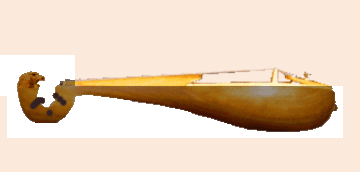
This is the envisioned rebec.
I hope to show a few of the basic
construction points on this page - details I left out of Conna's page
in order to actually give this page some more substance. Here
will be details on making bridges, tailpieces, installing fine tuners,
cutting and setting an antler nut, turning a tailpeg, and measuring for
the bridge and setting string action.
I will start with the same basic setup photos from Conna's page, as this instrument is the other half of the turning that I used to create Conna's instrument.
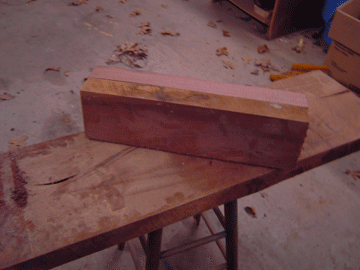
Here is a pair of walnut rebec blanks with a single white carpenter's glue line joining them right down the center. This glue is not meant to hold them for turning, merely to assure there is no slippage when I start turning the neck area. The blocks will be held together with plywood end caps which will also act as bearing surfaces for the lathe drive spur and tailstock center
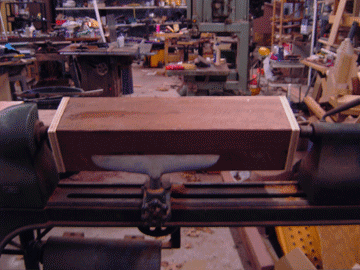
The set of blocks with the plywood caps , mounted in the lathe. This is a moderately heavy turning, and in well-seasoned walnut it requires sharp tools and a medium lathe speed.
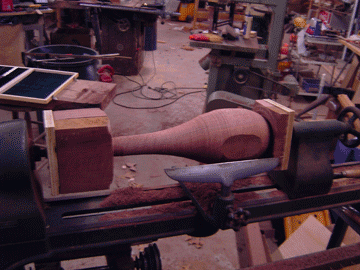
Here is the basic shape of the rebec body, with stock left full and square at the peghead end of the instrument. This will help me with a true, square layout of the scroll peghead.
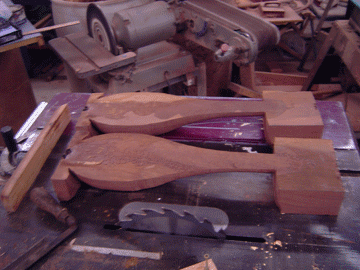
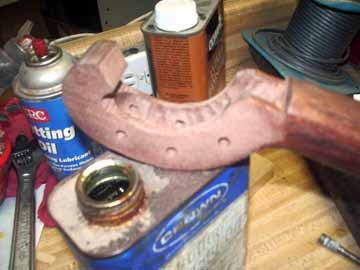
This is the scroll. Rather than creating a later period carved head, I decided to set a contrasting wooden carved plaque with an eagle head on the canted square end of the scroll. I have seen this in the work of modern replica builders, and in some of the iconic representations of rebecs in stone, paint, and simple drawings.
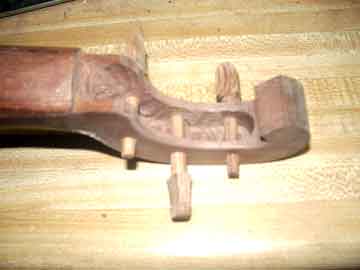
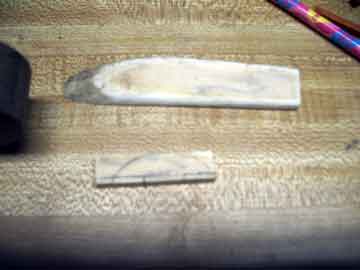
Here is a slab of antler I am using to make the nut. Simply sliced from one decent sized time of a large deer, I will use the more solid outside for the contact surface of the nut, and the more spongy part to promote good adhesive bond. The nut is cut to fit down into the scroll itself a small distance, for alignment, and is only about 1/16 inch higher than the fingerboard. The severe angle at which the strings deflect over the nut will allow me to make smaller notches, and so the nut can be a little shorter.
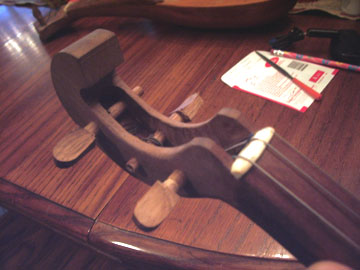
Here is the nut mounted in the scroll. It is flat on the inner surface, and curved and polished on the back (scroll) side. The stark contrast of hte white horn with the walnut and mahogany really looks nice. And the nut is strong.
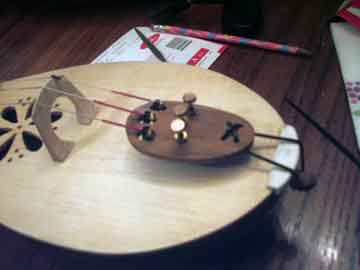
Here is the business end of the instrument. The saddle, which keeps the tailgut from cuting into the soundboard, is made of antler as well. I know that fine tuners aren't period, but they are so very useful for amateur performers who want to be able to play conveniently, and I believe in them. The tailpiece is very subdued Zebrawood, as is the tailgut pin. The tailgut is really gut, from an old harp string. I just think that the black looks cool.
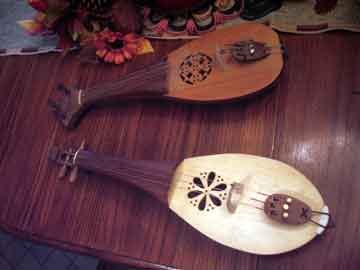
Here is the nearly finished instrument (it's playable, but needs the final oil and the carved plaque on the end ofthe scroll. Since Nancy is local, I am letting her play it with just a base oil coat on it, to let her decide if I have to make any changes that would otherwise mess up the final finish, like changing the neck thisckess. Once she is sure it is how she wants it, I am going to finish it in hard oil, and then make a recording of it to put on this page. Although I was fortunate enough to get a preview when I delivered it - and I am both humbled and a little concieted that the instrument sounds as good as it does. I think the pair of them look great (the one in the back is my personal instrument).
I will start with the same basic setup photos from Conna's page, as this instrument is the other half of the turning that I used to create Conna's instrument.

Here is a pair of walnut rebec blanks with a single white carpenter's glue line joining them right down the center. This glue is not meant to hold them for turning, merely to assure there is no slippage when I start turning the neck area. The blocks will be held together with plywood end caps which will also act as bearing surfaces for the lathe drive spur and tailstock center

The set of blocks with the plywood caps , mounted in the lathe. This is a moderately heavy turning, and in well-seasoned walnut it requires sharp tools and a medium lathe speed.

Here is the basic shape of the rebec body, with stock left full and square at the peghead end of the instrument. This will help me with a true, square layout of the scroll peghead.

Both of the basic rebec
blanks. The lower one became Conna's, the upper one, because of a
more dense grain in the peghead area, will become Nancy's.

This is the scroll. Rather than creating a later period carved head, I decided to set a contrasting wooden carved plaque with an eagle head on the canted square end of the scroll. I have seen this in the work of modern replica builders, and in some of the iconic representations of rebecs in stone, paint, and simple drawings.

The pegs for this instrument are
smaller than the pegs on those rebecs with flat pegheads, to keep the
holes as small as possible. This is a fine piece of wood, but it
is always good to remember your stress points and risers. The
pegs are tapered to the same taper as a custom peg reamer I built for
this job. I like the look of both the flat heads and the scroll,
this was an interesting diversion.

Here is a slab of antler I am using to make the nut. Simply sliced from one decent sized time of a large deer, I will use the more solid outside for the contact surface of the nut, and the more spongy part to promote good adhesive bond. The nut is cut to fit down into the scroll itself a small distance, for alignment, and is only about 1/16 inch higher than the fingerboard. The severe angle at which the strings deflect over the nut will allow me to make smaller notches, and so the nut can be a little shorter.

Here is the nut mounted in the scroll. It is flat on the inner surface, and curved and polished on the back (scroll) side. The stark contrast of hte white horn with the walnut and mahogany really looks nice. And the nut is strong.

Here is the business end of the instrument. The saddle, which keeps the tailgut from cuting into the soundboard, is made of antler as well. I know that fine tuners aren't period, but they are so very useful for amateur performers who want to be able to play conveniently, and I believe in them. The tailpiece is very subdued Zebrawood, as is the tailgut pin. The tailgut is really gut, from an old harp string. I just think that the black looks cool.

Here is the nearly finished instrument (it's playable, but needs the final oil and the carved plaque on the end ofthe scroll. Since Nancy is local, I am letting her play it with just a base oil coat on it, to let her decide if I have to make any changes that would otherwise mess up the final finish, like changing the neck thisckess. Once she is sure it is how she wants it, I am going to finish it in hard oil, and then make a recording of it to put on this page. Although I was fortunate enough to get a preview when I delivered it - and I am both humbled and a little concieted that the instrument sounds as good as it does. I think the pair of them look great (the one in the back is my personal instrument).
